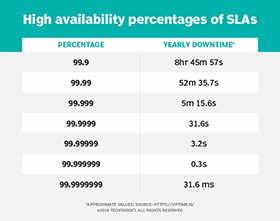
Compare niche cloud services to the hyperscale offerings
Consider your enterprise's specific needs when choosing between niche clouds and hyperscale clouds. Here's an overview of what you should know about both options.
The term "public cloud" typically conjures images of the massive hyperscale vendors that offer a multitude of services. Yet, there is another type of public cloud that is lesser known to users -- one that might be more effective in the right scenario.
Single-purpose clouds, also known as special-purpose clouds, specialize in just one service, or a set of closely related services. These serve as an alternative to the large multi-purpose or general-purpose clouds, such as AWS, Microsoft Azure and Google Cloud, which offer more holistic sets of IT services.
When planning a cloud strategy, you'll have to choose a multi-purpose cloud that broadly covers all of your needs or find a niche cloud service to meet specialized demands -- you might even opt for a mix of both. But it's up to the developers, architects, admins and business leaders to figure out which option is right for their specific workloads.
Single- vs. multi-purpose clouds: An overview
There is no simple formula for choosing between a single- or multi-purpose cloud -- a business must weigh its particular needs and consider the details of each cloud model. Here are the top four factors to consider:
1. Cost
Because they operate at such a massive scale, general-purpose providers are typically able to offer more competitive pricing for their services. In addition, by consolidating cloud services on one platform, IT teams minimize data egress fees and are likely to achieve a lower overall cloud computing bill. However, the hyperscale clouds are not universally cheaper. For certain types of services, like data storage, niche providers can actually cost less because they're able to optimize their operations around a specific purpose.
2. Features
Since single-purpose vendors focus on niche cloud service, they tend to offer more robust features and options for their particular use cases. For example, vendors that specialize only in data analytics -- such as Talend Cloud and Informatica -- are likely to offer a wider selection of tools and configuration options for those services. Larger public cloud providers will have similar data analytic services, such as Azure HDInsight or Amazon Elasticsearch Service, but those are only small parts of much larger portfolios, so they may not receive as much attention as you would like.
3. Reliability and availability
With dozens of data centers spread across the globe, public clouds like AWS, Azure and Google Cloud Platform offer high reliability and availability -- especially if you take advantage of features like geo-replication in which data is stored in multiple locations. The sheer size of these clouds means that incidences of downtime or data loss are very uncommon and a majority have high uptime percentages.

Most single-purpose cloud providers offer reasonably high levels of reliability and availability, even if they can't match the redundancy levels of their larger competitors. For most companies, these niche cloud services sufficiently accommodate their uptime requirements and prove to be just as effective at helping them to meet their business objectives. However, workloads that require extremely high levels of availability will typically fare better in a general-purpose cloud.or example, a finance application that handles transactions would create critical disruptions for users if it experienced downtime.
4. Longevity
The hyperscale, multi-purpose clouds are unlikely to go out of business anytime soon. Nor are they likely to get acquired, which can lead to fundamental changes in their services or force users into an ecosystem they would not otherwise choose.
That is not the case with single-purpose clouds, whose smaller size and targeted feature sets make them more susceptible to failing or being acquired. The classic example is Nirvanix, a single-purpose cloud that focused on data storage and went out of business with little warning in 2013. For acquisition examples, look at Cloud9, which Amazon bought in 2016. The service is still available, but it's now part of the AWS ecosystem. Or consider CloudEndure, a cloud backup and recovery provider acquired by AWS in 2019. It's also still available, but it's unclear how well its software will support clouds other than AWS in the future.
Editor's Note: This article is part 1 of two-part series. Please click here to read through specific examples for both single- and multi-purpose clouds.






